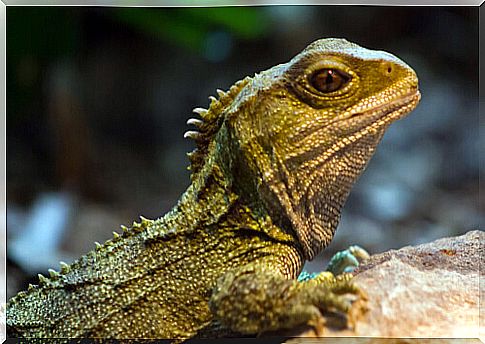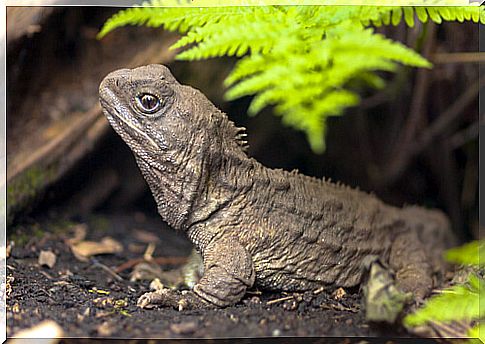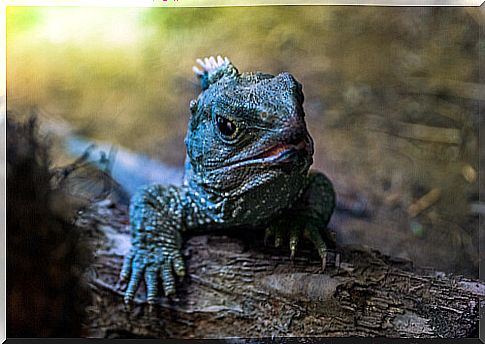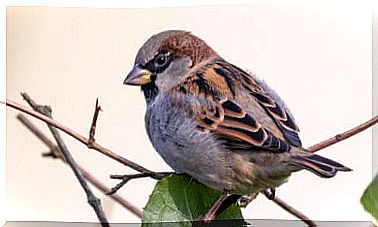The Tuátara: A Survivor Of The Age Of Dinosaurs

The tuátara is a reptile belonging to the order of the rhinocephalus, and it is endemic to New Zealand. It resembles a lizard, but has characteristics of the reptiles of the Tertiary era, and is that its lineage dates back 200 million years, during the Triassic.
Classification
The tuátara is classified in the order of the rhinocephalic. This order of diapsid reptiles is extremely ancient. Its maximum expansion occurred in the Jurassic, to be inevitably driven to extinction during the Cretaceous.
60 million years ago – approximately – practically all the species of this order disappeared. Except one. The species that is still present today is Sphenodon puntactus , called tuátara neocelándes.
However, there is another species, Sphenodon guntheri , as well as a subspecies, Sphenodon puntactus puntactus . They can be differentiated because S. guntheri is significantly smaller than S. puntactus .
Characteristics of the tuátara
This ‘living fossil’ is characterized mainly by the spiny crest present in both females and males, although it is less visible in female specimens. On the other hand, its soft and rough complexion is part of a large head.
This species also lacks external ears. On the other hand, their limbs have been observed to be robust and developed. In relation to size, they can reach 50-70 centimeters in length and weigh between 0.5 and 1 kilos.
They are extraordinarily long-lived animals with slow development. Females do not begin to reproduce until they are 20 years old. Once they have reproduced and laid eggs, the eggs do not hatch until two years after fertilization.

It is estimated that their life expectancy can reach a century. Therefore, the reproduction itself is a somewhat rare event.
Habitat and diet of the tuátara
The two species and the subspecies are located in different geographical regions, specifically in the two archipelagos throughout New Zealand :
- Sphenodon puntactus. The common tuatara is present on the North Island of New Zealand.
- Sphenodon guntheri . Present in the islets of the Cook Strait, it was discovered in 1989.
They are land animals, preferring rocky terrain, particularly rocky shores. This reptile has the peculiarity that it breathes slowly; at rest, an hour may elapse between one inhalation and the next.
They are carnivorous and insectivorous nocturnal animals : they have a varied diet, and it is that they feed on insects, snails, eggs, young birds or lizards. Cannibalism has occasionally been reported.
Conservation
Tuataras are animals at risk of extinction. They were included in the red list in 1996. And currently they have been classified as animals of lower risk or lower concern ( lower risk in English).
At present the exact number of individuals that make up this genus is not known. However, it has been revealed that the population is severely fragmented.

Among the measures that are part of the conservation plan, the following stand out:
- Creation of shelters.
- Translocation of frogs, to favor the feeding of reptiles.
- Transfer or control of mammals.
- Reintroduction in national parks.
The tuátaras were at risk of extinction a few decades ago due to human action, which meant the loss of part of their habitat. Additionally, the introduction of new species, such as rats or mustelids, reduced the extent of their habitat and food.
Curiosities about the tuátaras
The tuátaras were contemporaries of the dinosaurs approximately 240 million years ago. Although by evolutionary convergence they may be thought of as relatives of iguanas, in reality they are not closely related in time.
To date, it has not been possible to discover the function of the ‘third eye’ or ‘pineal eye’ of the tuatara, located in the upper part of the skull. Inside it, through a layer of connective tissue, the pineal organ is protected. It is believed to be sensitive to light and studies suggest that it picks up infrared radiation, which helps them when hunting.
The pineal gland usually has different functions depending on the group in which it is found. In reptiles it is responsible for regulating body temperature, while in mammals it is responsible for controlling the duration of the day-night cycle. It also regulates seasonal behavior, such as hibernation or heat.
Tuataras, in contrast to other reptiles, like the cold. They are able to survive in temperatures of 5ºC during hibernation. However, temperatures above 25ºC are lethal for tuataras.









